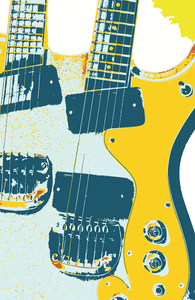
Don’t be shocked, but does the idea of getting to check out a brand-new exhibit at the National Music Museum electrify you? Does exploring historical musical instru- ments make you feel energized and recharged? Then we have just the exhibit for you! Set to open during the University’s annual “Dakota Days” celebrations, the NMM will feature its first temporary exhibit, “NMM Goes Electric!,” in the Groves Gallery for Special Exhibitions, of the newly constructed Lillibridge Wing.
This all-electric exhibit will be free and open to the public on Fridays, Saturdays, and Mondays from 10 AM to 2 PM between October 1 and December 13.
Even though the NMM’s permanent galleries are still in the process of development, we simply could not wait any longer to let you into our beautiful new facility in order to shed light on some of our premiere instrument collections and NMM Live! programming.
Temporary exhibits in the new Groves Gallery will allow us to enhance our public programming and share more of our collections and enlightening stories. The NMM has one of the largest and most interesting musical instrument collections in the world and we intend to highlight a wide array of new topics in the coming years. The first of these exhibits, “NMM Goes Electric,” interprets electric stringed instruments in the NMM’s permanent
collections, including many that have never previously been highlighted!

This first exhibit explores eight main themes.
“Early Days” peers into the past with some of the earliest electric stringed instruments brought to market in the 1930s, some of which have pivotal roles in the devel- opment of their types. “Going Low” focuses on electric basses, which posed their own challenges for elec- trification. The exhibit will also debut the Museum’s whimsical “toilet-seat bass” made by master luthiers Semie Moseley and Robert Venn in the 1960s! “The Classics” will illuminate some of the NMM’s most celebrated vintage electric guitars. “Eddie Peabody and the Banjoline”spotlights one of the most fascinating and successful virtuoso banjo players and the electric instruments he created with major American manufacturers. “Electric Guitars Behind the Iron Curtain” uncovers the little-known history of the Jolana company of Czechoslovakia that produced electric guitars during the communist period. Could you imagine a Polish surf band in the 1960s? Well, there was a brilliant one called the Tajfuny, or Typhoons, and the NMM preserves one of their electric guitars! “The Electric Guitar Heads to East Asia” examines the gradual migration of electric guitar manufacturing westward, from early manufacturing in post-war Japan, to a Vietnamese guitar made for an American serviceman, to Fender’s Japanese division, and then to China, with a beautifully sleek, hardwood electric ukulele. “The Independents” shines light on the work of smaller American companies, some defunct, and others thriving. Finally, “Digital Revolution” blends computers with guitars, as MIDI technology challenges the definition of what a musical instrument really is.
We are excited to be able to showcase some off-the-beaten-path stories and NMM instruments that have been patiently awaiting their turn to be discovered. As an institution devoted to public programming, education, and research, we delight in helping uncover aspects of musical instrument history that you may have never encountered before—jolting your imagination to think of instruments in shocking new ways.
Thank you for your patience and support while we have been under construction – welcome back!

















Comments